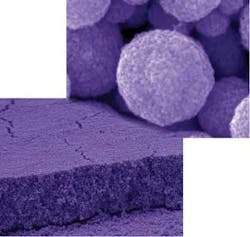Popcorn-shaped nanocrystallites double efficiency of dye-sensitized solar cells
Inexpensive and efficient solar cells are the “holy grail” in photovoltaic research, and a new type of film composed of tiny balls may significantly improve efficiency without increasing cost. The dye-sensitized solar-cell device incorporates hierarchically structured zinc oxide (ZnO) films as the photoelectrodes, which enhances energy-conversion efficiency. The 10-µm-thick film uses a popcorn-ball design consisting of spheres of grains just 15 nm across, clumped into balls with diameters from several tens to several hundreds of nanometers. The design effectively scatters light while providing a porous, large internal surface area.
To make the polydisperse ZnO aggregates, materials-science professor Guozhong Cao’s group at the University of Washington (Seattle, WA) combined zinc salt in a polyol medium at 160ºC and stirred vigorously for eight hours. The conversion efficiency of the solar cells was 6.2%—double the previous value for cells using structured ZnO films. The team plans to transfer the technique to titanium oxide, which may take the efficiency of DSCCs to new levels. Contact Guozhong Cao at [email protected].
